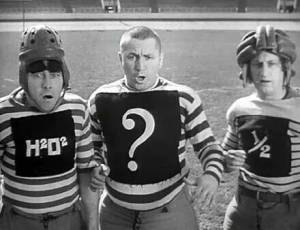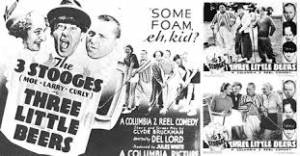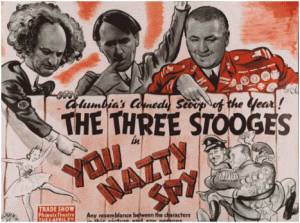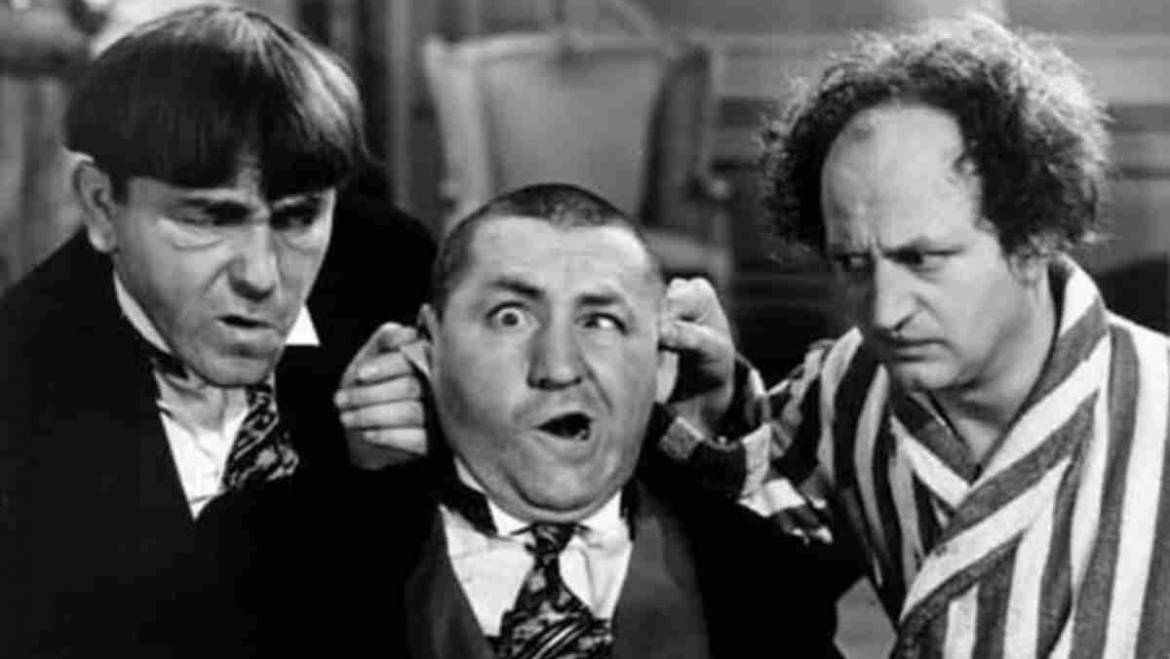It was a raucous and rollicking scene at a pair of addresses—9880 Marlin and 9853 Champa—in east Dallas throughout the 1960s. Along with one or two of my brothers, I sat on the living room floor, watched the comedic stylings of the Three Stooges and laughed uproariously. Our mother very much disapproved, fearing that we would adopt the vulgarian ways of Moe, Larry and Curly. You know, slaps, kicks, two-finger eye-pokes, nose-honks, head-conks, boxed ears and much more. The Stooges’ brand of humor was clearly low-brow, but was it so much worse than Charlie Chaplin, the Marx Brothers or Jerry Lewis? In response to Mother Dearest, who scowled and sometimes even turned off the TV, we could  only assert that they were funny. While I am prepared to admit that watching them did little to hasten our intellectual development, they nonetheless gave us mirthful pleasure in abundance.
only assert that they were funny. While I am prepared to admit that watching them did little to hasten our intellectual development, they nonetheless gave us mirthful pleasure in abundance.
The value of laughter
Savoring such classic short films as Restless Knights, Pop Goes the Easel, Three Little Beers, Disorder in the Court, Wee Wee Monsieur, A Ducking They Did Go, In the Sweet Pie and Pie, Half-Wits Holiday and Phony Express, we laughed often, loudly and without restraint. Well, guess what? It has been scientifically proven that laughter strengthens the immune system, lowers stress, is capable of diminishing pain, triggers the release of endorphins (the body’s natural feel-good chemicals), improves blood flow and burns calories. Furthermore, a Norwegian study has concluded that people who laugh often live longer than those who don’t. Our parents could have their boring small-screen fare like Perry Mason or Meet the Press. The Three Stooges’ manic slapstick routines did it for us.
The whole thing started with three brothers, Moses (Moe), Samuel (Shemp) and Jerome (Curly) Horwitz from Brooklyn, all born around the turn of the century. They took the less Jewish-sounding name of Howard. The fact that they had no background in the entertainment business did not deter them. Curly, not originally part of the team, watched their vaudeville routine and hung around backstage. Let us not forget Louis Feinberg (Larry Fine) of Philadelphia who joined the act in 1928. When Shemp split off to pursue a solo career, Curly replaced him almost by default. Moe, generally the Stooges’ leader on and off the screen, was doubtful. His baby brother had trouble remembering lines and seemed to possess no special talent, but that perception soon changed. Curly became unquestionably the “star” of the Three Stooges and the one most beloved by fans from Dallas to Joliet, from Tallahassee to Portland.
Moe, Larry—and, of course, Curly

How to characterize them? Moe was gruff and dished out physical and verbal abuse to the other two; Larry (who had long, straggly hair and ought to have been the one named “Curly”) was somewhat of a background guy, bridging the more brazen Stooges; and Curly (whose contract required him to shave his head) proved to be a comedic genius. Moe’s most frequent target, he had an unquenchable zest and often improvised in ways hilarious: his trademark yelps of “nyuk, nyuk, nyuk” and “woob, woob, woob,” his barking like a dog and his other mannerisms came from somewhere deep within him. None of this stuff was choreographed. How about the Curly shuffle—the subject of a popular 1984 song of that name—or the Curly spin, where he suddenly fell to the floor and twirled around like a top? He has been called the original break dancer. A unique and natural talent, he was the Mozart of physical comedy. Curly had an uncanny ability to heighten amusing possibilities in all kinds of scenes, especially those resulting from Moe’s enraged whacks.
As often as not, they played working-class guys who challenged stuff-shirted men and matrons. One of their more notable films was You Nazty Spy! A spoof of Nazi Germany, it came out in January 1940, nine months before Chaplin’s The Great Dictator. Moe played the Hitler role, Larry was Goebbels, and Curly was a blend of Goring and Mussolini.
The Three Stooges in their various incarnations (Shemp came back in 1946 after Curly suffered a stroke, and two other men tried and mostly failed to replicate Curly) made about 200 short films for Columbia Pictures. The company raked in large amounts of money from these little movies, but payment was not remotely commensurate. Signing 23 straight one-year contracts, the Stooges always struggled financially. One reason is that Columbia boss Harry Cohn and his Mafia connections terrified them.
No. 1 in kitsch
Curly had been dead for six years when, in 1958, many of their works went into syndication for TV broadcast. An entirely new generation of fans—like me and my brothers in Texas—came to appreciate their rather unsophisticated humor. Some commentators hold that the Three Stooges top even Marilyn Monroe and Elvis Presley for kitsch-cult supremacy in the USA. Not bad for a trio of ugly buffoons who specialized in hijinks, roughhousing and monkey business. They have inspired tributes in film, television, music, literature (comic books, magazines and novels), video games and even computer programming languages.
Every year, Fort Washington, Pennsylvania hosts a Three Stooges convention, and nearby Ambler has a Smithsonian-quality museum to honor Moe, Larry, Curly and Shemp. There are 2,000 dues-paying members of the Three Stooges Fan Club.


Add Comment